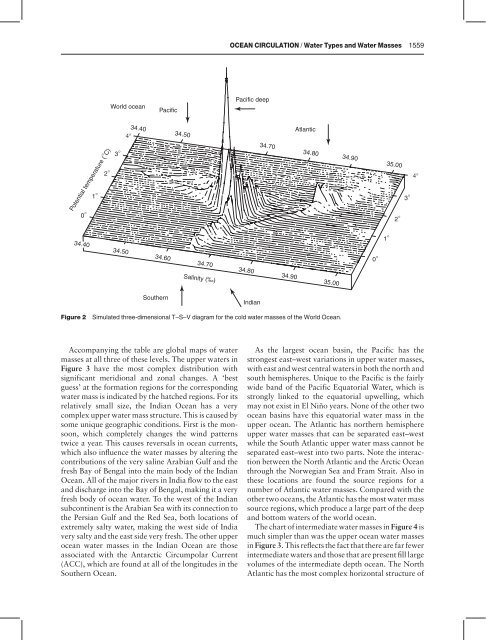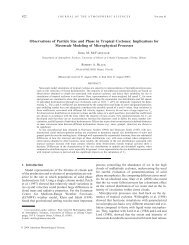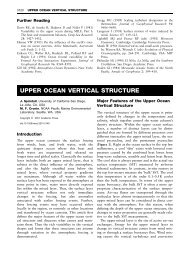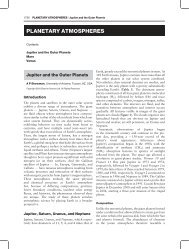Ocean Circulation - Water Types and Water Masses
Ocean Circulation - Water Types and Water Masses
Ocean Circulation - Water Types and Water Masses
Create successful ePaper yourself
Turn your PDF publications into a flip-book with our unique Google optimized e-Paper software.
OCEAN CIRCULATION / <strong>Water</strong> <strong>Types</strong> <strong>and</strong> <strong>Water</strong> <strong>Masses</strong> 1559<br />
World ocean<br />
Pacific<br />
Pacific deep<br />
4°<br />
34.40<br />
Atlantic<br />
0°<br />
1°<br />
2°<br />
Potential temperature (°C)<br />
3°<br />
34.50 34.70 34.80 34.90 35.00<br />
2°<br />
3°<br />
4°<br />
34.40<br />
1°<br />
34.50 34.60 34.70 34.80 34.90 35.00<br />
0°<br />
Salinity (‰)<br />
Southern<br />
Indian<br />
Figure 2<br />
Simulated three-dimensional T–S–V diagram for the cold water masses of the World <strong>Ocean</strong>.<br />
Accompanying the table are global maps of water<br />
masses at all three of these levels. The upper waters in<br />
Figure 3 have the most complex distribution with<br />
significant meridional <strong>and</strong> zonal changes. A ‘best<br />
guess’ at the formation regions for the corresponding<br />
water mass is indicated by the hatched regions. For its<br />
relatively small size, the Indian <strong>Ocean</strong> has a very<br />
complex upper water mass structure. This is caused by<br />
some unique geographic conditions. First is the monsoon,<br />
which completely changes the wind patterns<br />
twice a year. This causes reversals in ocean currents,<br />
which also influence the water masses by altering the<br />
contributions of the very saline Arabian Gulf <strong>and</strong> the<br />
fresh Bay of Bengal into the main body of the Indian<br />
<strong>Ocean</strong>. All of the major rivers in India flow to the east<br />
<strong>and</strong> discharge into the Bay of Bengal, making it a very<br />
fresh body of ocean water. To the west of the Indian<br />
subcontinent is the Arabian Sea with its connection to<br />
the Persian Gulf <strong>and</strong> the Red Sea, both locations of<br />
extremely salty water, making the west side of India<br />
very salty <strong>and</strong> the east side very fresh. The other upper<br />
ocean water masses in the Indian <strong>Ocean</strong> are those<br />
associated with the Antarctic Circumpolar Current<br />
(ACC), which are found at all of the longitudes in the<br />
Southern <strong>Ocean</strong>.<br />
As the largest ocean basin, the Pacific has the<br />
strongest east–west variations in upper water masses,<br />
with east <strong>and</strong> west central waters in both the north <strong>and</strong><br />
south hemispheres. Unique to the Pacific is the fairly<br />
wide b<strong>and</strong> of the Pacific Equatorial <strong>Water</strong>, which is<br />
strongly linked to the equatorial upwelling, which<br />
may not exist in El Niño years. None of the other two<br />
ocean basins have this equatorial water mass in the<br />
upper ocean. The Atlantic has northern hemisphere<br />
upper water masses that can be separated east–west<br />
while the South Atlantic upper water mass cannot be<br />
separated east–west into two parts. Note the interaction<br />
between the North Atlantic <strong>and</strong> the Arctic <strong>Ocean</strong><br />
through the Norwegian Sea <strong>and</strong> Fram Strait. Also in<br />
these locations are found the source regions for a<br />
number of Atlantic water masses. Compared with the<br />
other two oceans, the Atlantic has the most water mass<br />
source regions, which produce a large part of the deep<br />
<strong>and</strong> bottom waters of the world ocean.<br />
The chart of intermediate water masses in Figure 4 is<br />
much simpler than was the upper ocean water masses<br />
in Figure 3. This reflects the fact that there are far fewer<br />
intermediate waters <strong>and</strong> those that are present fill large<br />
volumes of the intermediate depth ocean. The North<br />
Atlantic has the most complex horizontal structure of








![Chapt 2.5 [PDF]](https://img.yumpu.com/24218624/1/190x146/chapt-25-pdf.jpg?quality=85)